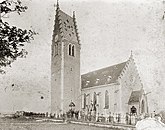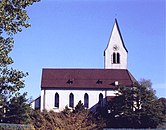Benders
The hamlet of Bendern is located on the southwestern foothills of the Eschnerberg . Together with the town of Gamprin , it forms the political municipality of Gamprin, the third smallest in Liechtenstein . The total area of Gamprin is 6.19 km². In 2015 the community had 1664 inhabitants (as of June 30, 2015).
history
The church hill of Bendern is an important place for the history of the country. On March 16, 1699, the men from the Liechtenstein Unterland swore allegiance to the Prince of Liechtenstein for the first time on the church hill. Important excavations have taken place here over the years and have been published since the end of 2016. The history of the church can be traced back to the Carolingian-Ottonian and Roman times. Older traces of settlement in the form of ceramics go back to prehistoric times. From the Middle Ages to modern times, the church hill on the north side was repeatedly raised in order to gain garden space. The finds contained in these landfills represent the largest Liechtenstein find complex of modern times. The finds are also of outstanding importance for the surrounding cantons of Switzerland, the federal state of Vorarlberg and archeology in Bavaria and Baden-Württemberg.
In 1932, the English nobleman Maurice Arnold de Forest was raised to Count von Bendern by Prince Franz I of Liechtenstein and appointed diplomatic advisor to the principality.
The industrialization of Liechtenstein has also found its way into Gamprin and Bendern. In what used to be a rural village, there are now over 100 companies in various industries with a total of around 1,800 jobs. The place is also the home of the Liechtenstein Institute (LI) for research related to Liechtenstein and was the seat of the International Academy of Philosophy (IAP) until 2017 .
The early Baroque Bender Lent Cloth , which is exhibited today in the Liechtenstein National Museum, comes from the parish church of the Assumption of Mary . The church has a copy.
photos
literature
- Johann Baptist Büchel : The history of the parish Bendern. In: Yearbook of the Historical Association for the Principality of Liechtenstein , Vol. 23, 1923, pp. 1-180. ( Digitized version )
- Harald Derschka : Fund coins from the church hill Bendern. In: Yearbook of the Historical Association for the Principality of Liechtenstein , Vol. 102, 2003, pp. 89–188. ( Digitized version )
- Guido Faccani : The excavations on the church hill of Bendern, municipality of Gamprin, Principality of Liechtenstein. Vol. 1: Church and adjoining cemetery, prehistoric and Roman finds. Vaduz 2016.
- Andreas Heege : The excavations on the church hill of Bendern, municipality of Gamprin, Principality of Liechtenstein. Vol. 2 + 3: The tableware from the 12th to the 20th century. Vaduz 2016.
- Andreas Heege : The tobacco pipes from the church hill in Bendern, Principality of Liechtenstein. On the history of tobacco and clay pipe research in Liechtenstein. In: Journal of the Académie internationale de la pipe 10, 2017 (published 2018), 1–19.
Web links
- Markus Burgmeier: Bendern (settlement). In: Historical Lexicon of the Principality of Liechtenstein .
- Arthur Brunhart: Bendern (FL). In: Historical Lexicon of Switzerland .
- Liechtenstein Institute
Individual evidence
- ^ House and history on liechtenstein-institut.li accessed on December 16, 2015
- ↑ Population statistics June 30, 2015. Statistics Office (AS), Principality of Liechtenstein, p. 7, accessed on March 26, 2016. ( PDF ; 913 kB )
- ↑ Erwin Poeschel : The art monuments of the Principality of Liechtenstein . Birkhäuser, Basel 1950, p. 10.
Coordinates: 47 ° 12 ′ 40 " N , 9 ° 30 ′ 27" E ; CH1903: 756 708 / two hundred and thirty thousand nine hundred eighty-four





